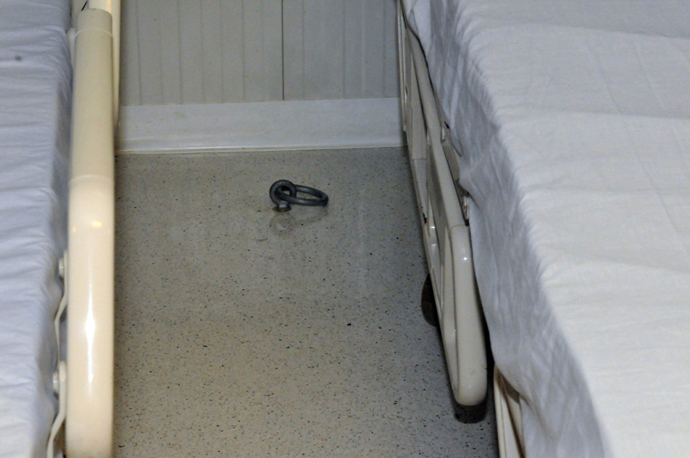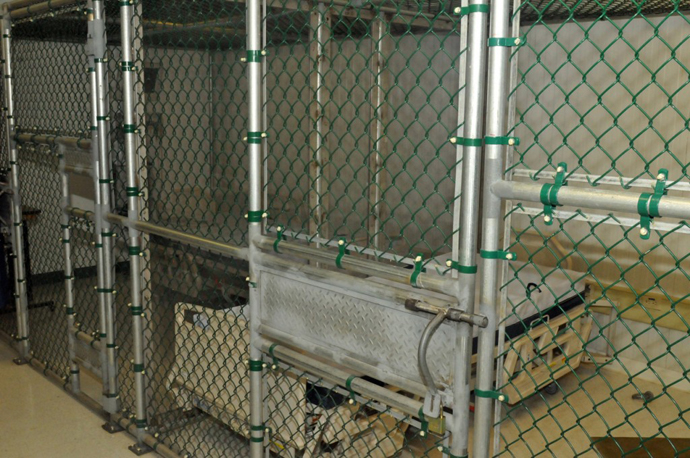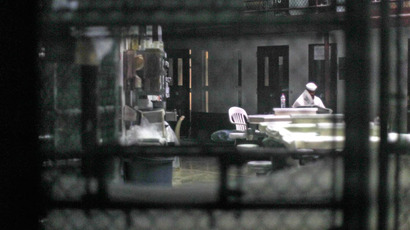Shackles, masks and nasal tubes: Gitmo revises force-feeding techniques (PHOTOS)
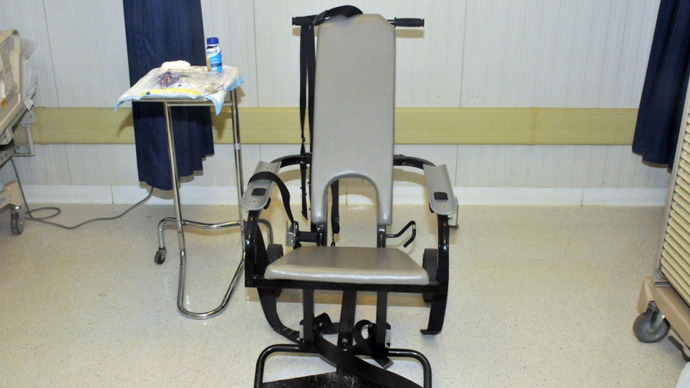
Hunger strikers being force-fed at Guantanamo Bay must wear masks over their mouths while being shackled to a restraint chair for up to two hours. Authorities have revised the way they feed the strikers, comparing their techniques to battlefield tactics.
Nasal tubes are jammed up the prisoners’ noses until a liquid supplement reaches their stomachs. The tubes, which are 61cm in length or even longer, stay in the prisoners’ nostrils until a chest X-ray or a test dose of water show that the nutritional supplement has reached the prisoner’s stomach.
The shocking procedure doesn’t stop there. Detainees are then sent to a “dry cell” with no running water while they undergo supervision to make sure they don’t vomit. If they regurgitate their supplement, they’re sent right back to the restraint chair.
Details of the "chair restraint system clinical protocol" were published in a newly revised Standard Operating Procedure (SOP) for Guantanamo hunger strikers. The document was obtained by Al Jazeera, from the United States Southern Command (SOUTHCOM), which has oversight over the joint task force that operates the highly controversial prison.
The new policy went into effect March 5, just one month after Guantanamo detainees launched the hunger strike in response to alleged mistreatment and mishandling of their Korans.
"Just as battlefield tactics must change throughout the course of a conflict, the medical responses to GTMO detainees who hunger strike has evolved with time," the revised SOP says. Two weeks ago, 40 more nurses were sent to Guantanamo Bay to assist with force-feedings.
Force-feeding is an extremely invasive and highly controversial practice which many human rights activists - and the UN - say is torturous. But what’s perhaps even more shocking than the procedure itself is that the final decision regarding who will be force-fed is left up to Guantanamo Commander John Smith - not physicians.
“In the event a detainee refrains from eating or drinking to the point where it is determined by the medical assessment that continued fasting will result in a threat to life or seriously jeopardize health, and involuntary feeding is required, no direct action will be taken without the knowledge and written approval of Commander [Navy Rear Adm. John Smith, Jr.],” the document says.

While doctors are, in fact, present at the site, they exist solely to carry out the military’s commands.
According to Leonard Rubenstein, a lawyer at the Center of Public Health and Human Rights at Johns Hopkins University and the Berman Institute of Bioethics, the document is alarming because it makes clear that doctors and nurses are simply “adjuncts of the security apparatus.”
"The clinical judgment of a doctor or a nurse is basically trumped by this policy and protocol. Doctors are not acting with the kind of professional medical independence,” he said.
Giving Cmdr. Smith such extreme power to decide who gets force-fed “violates core ethical values of the medical profession,” American Medical Association president Dr. Jeremy Lazarus wrote in a letter to Secretary of Defense Chuck Hagel last month.
“Every competent patient has the right to refuse medical intervention, including life-sustaining interventions,” he wrote. “The AMA has long endorsed the World Medical Association Declaration of Tokyo, which is unequivocal on the point: ‘Where a prisoner refuses nourishment and is considered by the physician as capable of forming an unimpaired and rational judgment concerning the consequences of such a voluntary refusal of nourishment, he or she shall not be fed artificially.’”
But authorities seem to place less value on the rules and ethics of the World Medical Association Declaration than Lazarus does. According to the SOP, medical professionals will make “reasonable efforts” to gain consent from prisoners, but will perform the procedure without being granted such permission.
According to one detainee, Kuwaiti-born Fayiz al-Kandari, the nasal tubes used in the procedure are large, painful and come with hazardous side effects.
"It takes several attempts to get the tube into the right place,” his lawyer, Carlos Warner, said. “Once it goes down his throat he has a difficult time breathing. There’s a gag reflex.”
But the SOP says otherwise, claiming that the force-feeding can "be completed comfortably over 20 to 30 minutes."
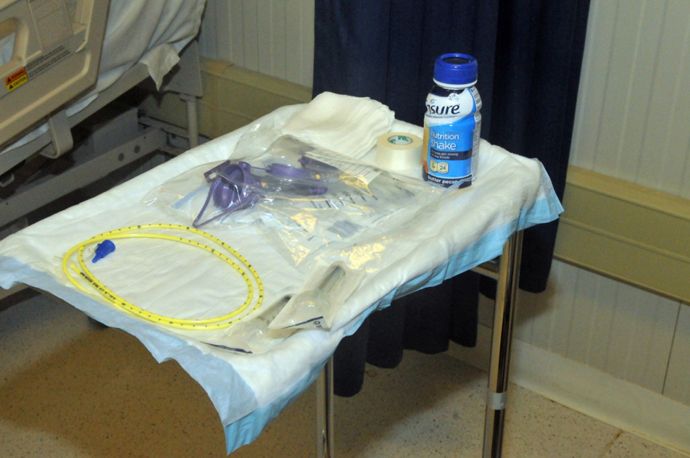
Guantanamo spokesman Lt. Col. Samuel House said that medical professionals who conduct the force feedings “carefully evaluate each patient to determine the appropriate size of tube to use.” He added that the sizes of the tubes used “should not be a big problem in an adult.”
Those on the receiving end of the force-feeding disagree. However, they have no option but to sit shackled to the restraint chair and let the procedure take place against their will - because the anti-spitting and biting masks are in place to prevent them from interrupting the process.
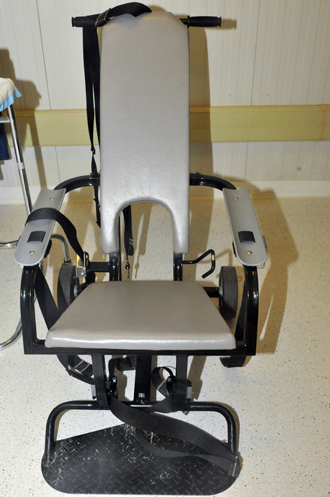
If the inmates do succeed in biting the feeding tubes, they face even more force and discomfort.
“If the detainee is able to get the [enteral feeding] tube between his teeth, the RN [registered nurse] shall…direct the guard staff to stabilize the detainee’s head in the midline position…hold traction on the tube for as long as necessary for the detainee to relax his jaw; then continue safe removal of the tube. This may take considerable time,” the document says.
While the detainees show no signs of ending their hunger strike, US authorities at the prison remain determined to follow the practices outlined in the SOP - despite any criticism from human rights activists or the UN.
And it seems US President Barack Obama doesn’t have a problem with the force-feeding techniques.
Less than two weeks ago, the President said he believes the “Pentagon is trying to manage the situation as best as they can,” adding that he doesn’t want “these individuals to die.”
Obama vowed to close down Guantanamo at the beginning of his first term in office in 2009. However, he was blocked from fulfilling that promise by legislation passed by the US Congress.
Less than two weeks ago, Obama vowed to “re-engage with Congress to try to make the case [Guantanamo] is not something that’s in the best interests of the American people.”
There are currently 100 inmates participating in the hunger strike at Guantanamo Bay, 29 of whom are receiving enteral feeds. Five of those prisoners are being observed in the detainee hospital, Lt. Col. Samuel House said in a Monday statement. The official numbers differ from those of human rights activists, who have put the number of strikers up to 130.
